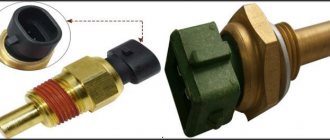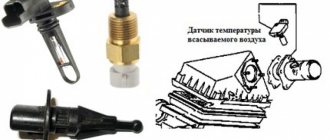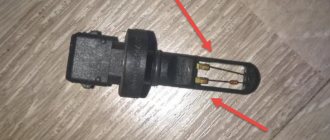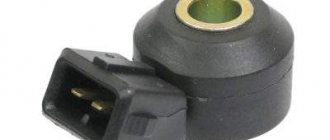On a modern car, several systems and a large number of sensors simultaneously monitor the operation of the engine and adjust its behavior when internal and external parameters change.
If any malfunctions or irregularities appear in the operation of the internal combustion engine, they are recorded by the control unit (ECU) and stored in memory. These errors may appear as lights on your dashboard. Most often we are talking about Check Engine.
One of the errors that motorists may encounter when connecting to the ECU with a scanner is P0113. You should know what it means, what symptoms it is accompanied by and how to eliminate it on your own.
Technical description and explanation of error P0113
This diagnostic trouble code (DTC) is a generic powertrain code. The P0113 code is considered a common code because it applies to all makes and models of vehicles. Although the specific repair steps may vary slightly depending on the model.
To obtain more power from the engine cylinders, forced induction from one of them is used. By forcing more air into the cylinder, more oxygen is produced during the combustion process. Therefore, the ECM (engine control module) injects more fuel, resulting in more power.
Forced induction motors have two IAT (inlet air temperature) sensors whose resistance varies with temperature. As the temperature increases, the resistance decreases. Low temperature results in high signal voltage.
When the PCM sees a signal voltage greater than 5 volts for IAT sensor #1. The Check Engine Light comes on and DTC P0113 OBDII is stored.
How to fix error P0113
Having seen an alarming signal, you should not immediately go to the store to buy it, especially since for some models and brands of foreign-made equipment it is not cheap. There is no guarantee that after replacing the part with a new one, the error code will disappear.
In a dual version with a mass air flow sensor, its cost can be more than 5,000 rubles.
If error P0113 has caused the engine to idle unevenly, you can try disconnecting the mass air flow sensor connector. If at the same time the speed becomes consistently high, it may not be the sensor.
Next, you need to check the resistance of the sensor using a multimeter. In this case, you need to find the pinout of the connector.
At negative ambient temperatures, the resistance should be several kiloohms. When heated, the resistance should drop to hundreds of ohms. A more specific dependence of the DTVV resistance on temperature should be looked for separately for your car brand.
In some cases, cleaning (rinsing) the DTVV with special means helps.
Video - Audi A6 C5 intake air temperature sensor (checking, cleaning DTVV):
One of the simple, inexpensive and reliable methods for checking the operation of sensors is to install a known working one. In this case, you can erase all errors, warm up the engine, make a test drive for at least 10 minutes, then carry out computer diagnostics. If the error disappears, the original sensor should be replaced.
Video - replacing the air temperature sensor on the Opel Astra N:
One of the possible rare causes of error P0113 is a malfunction in the engine control unit. To power this sensor, the control unit has a special voltage stabilizer chip. A stable (reference) voltage of 5 (or 9) Volts is supplied to one of the sensor contacts. Its exact value can be checked using a multimeter. The specific contact number can be determined from the diagram. The sensor should be turned off during the measurement. If the reference voltage does not match (more than the reference voltage or is absent), it is necessary to repair the engine control unit. In this case, the help of a specialist is needed. To check, you can “throw” an unlocked block for testing.
Some engine models, especially V-shaped ones, may have two intake air temperature sensors. In this case, a general error message P0113 is allowed. Each sensor must be monitored individually. In this case, standard techniques are used:
- removing the sensor connectors one by one;
- replacing sensors;
- simultaneous removal of sensor connectors.
During the process of dismantling and installing sensors, extreme care should be taken: the working element of the sensor is small in size and durable, it can be easily damaged.
Sensor check
- With the key in the off position, disconnect the DTVV. With the multimeter set to resistance (ohms) mode, measure the resistance at the sensor terminals. If you get an open circuit or short circuit (∞ Ω or 0.0 Ω), the sensor is faulty. Replace the DTVV.
- If you measured the resistance, compare it to the temperature ⁄ resistance chart. If the engine is cold, then the temperature ⁄ resistance of the IAT should be close enough to the ambient temperature that can be measured with a thermometer. If the resistance matches the ambient temperature, you may still have a problem with the sensor. A sensor that operates correctly at ambient temperatures may be out of range at other temperatures. You can check if the sensor is faulty by measuring the resistance after changing its temperature, for example by placing it in a pan of boiling water or in the freezer.
This is interesting: Practical tips and recommendations for replacing the fog lamp on a Renault Logan car
Checking the circuit
If the sensor itself seems to be responding correctly to temperature changes, then you can begin testing the circuit.
- With the ignition key turned on (key on, engine off), disconnect the IAT sensor and check the voltage at the connector. There should be 5 volts on one of the wires. If you don't have 5 volts, there may be an open circuit or a faulty ECU.
- The other wire should read 0V. If you can identify the signal wire correctly, check the resistance to ground, which should be 0.0 ohms. An open circuit probably means you have a wiring problem. On the other hand, 0.0 ohms may still indicate a ground fault.
- If there is no reference voltage of 5 V, there may be an open circuit between the ECU and the sensor, a short circuit to ground, or a malfunction of the controller itself. If there is no signal voltage on the other wire, the sensor may be faulty, an open circuit, or a short to ground.
- In the ECU, check the reference and signal voltage. If there is no 5 V, the problem may be in the controller. If the signal voltage is low or absent, check for corrosion or open circuit in the DTVV.
- Turn the key to the off position, disconnect the ECU connector and check the resistance. If the resistance reading matches the sensor, check if the ECU is faulty. If you measure "0.0 Ω" or "∞ Ω", check for an open or short in the wiring to the IAT sensor.
- Unplug the sensor and measure the resistance again, it should now display as an open circuit, "∞ Ω". If you get any resistance, check for a short in the wiring to the IAT sensor.
- Connect a jumper to the sensor connector and check the resistance in the circuit.
- The correct reading should be "0.0 ohms". Any resistance above 1 ohm may indicate corrosion or an open circuit.
- Check resistance to ground. Any resistance below 1000k ohms may indicate a short to ground in one of the IAT sensor wires.
- If you have a diagnostic scan tool, you can perform many of these checks simply by reading the sensor readings from the ECU. Turn the ignition key to read the temperature while the sensor is connected and then disconnected. If there is no change, you have a problem with the circuit. If there are changes, you have a problem with the sensor.
Symptoms of malfunction
The main driver symptom of P0113 is the MIL (Malfunction Indicator Light). It is also called Check engine or simply “check light”.
They can also appear as:
- The “Check engine” warning light on the control panel will light up (the code will be stored in the ECM memory as a malfunction).
- The vehicle engine may become unstable under load or acceleration.
- The engine runs on a fuel mixture that is too lean or too rich depending on the outside temperature.
- But more often, no symptoms are felt.
Conditions for generating an error
Such an error can only appear when certain conditions, a certain scenario, are met.
The error is recorded in the ECU when the engine starts. When starting the internal combustion engine, the ECU reads data from all sensors. If the air passing through the air duct has a density higher than the allowable value and this continues for more than 1.5 minutes, the check engine light will illuminate on the instrument panel.
If this is an accidental error, then after 4 normal starts the indicator on the instrument panel will go out. But the error itself will still be in the ECU memory. It is automatically erased only after 40 successful engine starts.
Reasons for the error
Code P0113 may mean that one or more of the following problems have occurred:
- Internal malfunction of IAT sensor No. 1.
- Faulty connection on IAT sensor #1.
- The IAT sensor signal circuit may be shorted.
- Sensor wiring is routed too close to high voltage wiring (eg alternator, spark plug cables, etc.).
- The intake air temperature sensor wiring harness is open or shorted.
- The connector is damaged or the engine control module (ECM) circuit is open.
The intake air temperature (IAT) sensor contains a semiconductor device that changes resistance depending on temperature (thermistor). It is located in the engine intake duct and has a signal circuit and a ground circuit. The powertrain control module (PCM) monitors the sensor signal and sets the P0113 OBDII code. When the intake air temperature sensor signal is outside the factory specification.
Checking the mass flow sensor with your own hands
In order to carry out the test, you must first ensure that the electrical wiring is in good condition. To do this, you can use a multimeter. The check is performed as follows:
- The power supply cable in the VAZ 2114 has 5 contacts. They need to be numbered from 1 to 5.
- You need to measure the voltage between 2 and 3. It should be approximately 15 V. Between 3 and 4 the voltage should be 5 V.
- If you measure it between 3 and mass, then it should be equal to 0 .
- Now the multimeter is switched to measuring resistance. Between contact 5 and ground its value should be zero.
If the obtained values correspond to the expected ones, then the power supply wire is working, and the cause of the breakdown must be looked for elsewhere.
You need to check the operation of the thermal resistance. To do this, use a hairdryer or warm water. With their help you can change the temperature of the sensor. It is necessary to measure the resistance before and after heating. The readings must vary proportionately.
You need to inspect the sensor and make sure that there is no dirt on it that could distort the signal it transmits.
Scheme of work
How to Troubleshoot or Reset Trouble Code P0113
Some suggested steps to troubleshoot and fix error code P0113:
- Check the IAT sensor wiring or connectors for a problem. You must repair or replace these components if they are in poor condition.
- Make sure the intake air temperature sensor is installed correctly and in the correct location. Make appropriate adjustments.
- Use a fault scanner to check the IAT sensor readings. If the engine is cold, the readings should match those of the coolant temperature sensor. If there are differences in comparison, measure the resistance at the two terminals of the IAT sensor. It must be replaced if it does not meet the resistance requirements.
- Check continuity between ground and IAT sensor signal cable.
- Make sure 5 volts is present. Repair if necessary.
What does code P0113 mean?
P0113 is triggered when the engine control module (ECU) reads a high voltage signal in the Intake Air Temperature (IAT) sensor circuit.
On most cars, the DTVV is located in the air intake housing. Inspect the intake air system and look for a barrel-shaped sensor with a two-wire connector.
If you don't find two wires, the IAT may be integrated with the mass air flow sensor (MAF). The temperature sensor can sometimes be found on the intake manifold.
Diagnosis and problem solving
Check with a scan tool to see if the IAT sensor can be read. If readings are taken and they are within tolerance, the problem is most likely intermittent. If the reading is less than -30 °C degrees, disconnect the connector.
Install a jumper wire between the harness connector signal circuits and the ground circuits. The IAT temperature reading on the scan tool should be as high as possible. For example, it should be 140 degrees Celsius or higher. If so, then the wiring is fine, there may be a problem with the connection.
If the scan tool is having trouble receiving data, it is likely that the sensor signal is missing due to a problem in the 5 volt line. Using a multimeter, check the signal continuity between the PCM connector and the IAT connector.
Probable Causes
Error P0113 hides certain reasons that led to the recording of the corresponding code in the memory of the control unit.
The main reason lies in a problem with the temperature sensor. But the occurrence of an error may be due to various malfunctions. The main ones are:
- breakdown of the temperature sensor, its complete failure;
- contamination of the controller with oil particles, which reduces sensitivity;
- loss of contact in the connector;
- broken wiring in the electrical circuit.
Statistics show that most often the reason lies in a short circuit in the circuit or in the sensor housing.
Much less often the device becomes contaminated with oil and other deposits, which entails a decrease in the sensitivity of the sensor.
On which cars is this problem most common?
The problem with code P0113 can occur on different machines, but there are always statistics on which brands this error occurs more often. Here is a list of some of them:
- Audi (Audi a4)
- BMW
- Cadillac
- Chery (Chery Tiggo)
- Chevrolet (Chevrolet Aveo, Captiva, Cruz, Lanos, Lacetti, Malibu)
- Chrysler (Chrysler Voyager, Pacifica, PT Cruiser, Sebring, 300c)
- Citroen (Citroen C4, Berlingo)
- Daewoo (Daewoo Nexia)
- Dodge (Dodge Intrepid, Caliber, Caravan, Stratus)
- Ford (Ford Galaxy, Kuga, Mondeo, Mustang, Transit, Fiesta, Focus, Fusion, Explorer)
- Honda (Honda Accord, SRV, Fit, Civic)
- Hover
- Hyundai (Hyundai Grand Starex, Porter, Santa Fe, Solaris, Sonata, Starex, Tucson, Elantra)
- Infiniti
- Isuzu
- Jeep (Jeep Grand Cherokee)
- Kia (Kia Bongo, Rio, Sorento)
- Land Rover (Land Rover Freelander)
- Lexus (Lexus rx300)
- Mazda (Mazda 3, Mazda 6, Mazda cx7, Demio)
- Mercedes (Mercedes w203)
- Mitsubishi (Mitsubishi Galant, Lancer, Pajero, L200)
- Nissan (Nissan Almera, Qashqai, March, Sentra)
- Opel (Opel Astra, Vivaro)
- Peugeot (Peugeot 307, 308, 407, Partner)
- Pontiac (Pontiac Grand AM)
- Rover
- Seat (Seat Alhambra)
- Skoda (Skoda Octavia)
- Ssangyong (Sangyong Kyron, Rexton)
- Subaru (Subaru Impreza, Legacy, Forester)
- Suzuki (Suzuki Grand Vitara)
- Toyota (Toyota Avalon, Avensis, Camry, Corolla, Land Cruiser, Rav4)
- Volkswagen (Volkswagen Passat, Touareg, Touran, Transporter)
- Volvo
- VAZ 2107, 2110, 2111, 2112, 2114, 2115
- Volga Chrysler, Cyber
- Gazelle Business, Chrysler, UMZ 4216
- Zaz Chance
- Lada Granta, Kalina, Niva, Priora
- Tagaz Tager
- UAZ Patriot
With fault code P0113, you can sometimes encounter other errors. The most common are: P0095, P0096, P0097, P0098, P0099, P0102, P0107, P0108, P0110, P0111, P0112, P0114, P0118, P0123, P0127, P0138, P0238, P0303, P0316, P034 0, P0351, P0453, P0708 , P1135, P1155, P1400.
Is it possible to continue driving a car?
A failure of the intake air temperature sensor, which stops providing information or detects it incorrectly, simultaneously leads to several unpleasant consequences. First of all, problems begin with the start of the power unit. This is due to the fact that the thermistor works in conjunction with the coolant temperature sensor. The data received from them allows you to accurately “calculate” the injection time, which is especially important when starting the engine “hot”. Along the way, other problems are identified:
- drop in engine power, deterioration in its throttle response;
- Unstable operation of the engine at idle speed.
Depending on the make of the car, there may be other consequences. For example, for cars made in the People's Republic of China Chery, fuel consumption may increase and the rear axle may no longer engage.
Symptoms
An error such as P0113 does not have pronounced and characteristic symptoms by which it could be accurately diagnosed. These are, rather, indirect signs that force the motorist to connect a scanner to the computer and read the errors in the memory.
You can suspect problems with the intake air temperature controller based on the following symptoms:
- the Check Engine light comes on on the dashboard;
- The ECU switches the engine to emergency or safe operating mode;
- fuel consumption indicators are increasing;
- If the car is all-wheel drive, the rear axle may spontaneously disengage.
If you continue to operate the car in such conditions, the wear of the valves and piston group increases. It is better to fix the problem as quickly as possible.
Yes, the symptoms discussed do not indicate that the intake air sensor has failed. But this is a reason to read the errors and look at their codes.
IAT connection diagram
The electrical circuit for DTVV is shown below:
The sensor is calibrated and produces a voltage proportional to the air temperature. Higher temperatures result in higher voltage being applied to the ECU because the internal resistance of the IAT decreases as it heats up.
Errors associated with high circuit input signal are mainly caused by faulty generators that create excess voltage. Although there may be other reasons, such as short circuits that "leave" current into a particular system from other, unrelated systems operating at higher voltages.
Note that in the case of short circuits, there are likely to be other seemingly unrelated fault codes present.
Diagnosing a "high input" code will always involve thorough testing of the charging system as a first step, followed by isolating the circuit from all other possible voltage sources while checking resistance, continuity, and voltage reference.
How to resolve error P0113?
The circuit is simple, just two wires going from the ECU to the IAT sensor. If you have a diagnostic scanner or adapter, you can use it to read the temperature directly. Otherwise, you can use a digital multimeter, a thermometer, and a jumper wire such as a thin wire or paper clip.
A table of temperature sensor resistance for your specific year, make, and model vehicle will be especially helpful. You can often find them online.
Sensor check
Checking the circuit
If the sensor itself seems to be responding correctly to temperature changes, then you can begin testing the circuit.
What does error P0113 indicate and how to fix it
On a modern car, several systems and a large number of sensors simultaneously monitor the operation of the engine and adjust its behavior when internal and external parameters change.
If any malfunctions or irregularities appear in the operation of the internal combustion engine, they are recorded by the control unit (ECU) and stored in memory. These errors may appear as lights on your dashboard. Most often we are talking about Check Engine.
One of the errors that motorists may encounter when connecting to the ECU with a scanner is P0113. You should know what it means, what symptoms it is accompanied by and how to eliminate it on your own.
How to eliminate an error in the incoming air temperature
Often, when car owners take readings from a car scanner, the display of which displays the code p0113, after receiving the decoding, they immediately look for the location of this sensor and rush to replace it with a new one. Although it is not always reasonable to do this, because there is no 100% certainty that error p0113 will go away after replacing the air pressure sensor or mass air flow sensor. Therefore, it often happens that I changed it, but the error does not go away - what should I do?
Tips for eliminating P0113 high signal level of the incoming air sensor are quite simple:
First you need to check the resistance of the IAT sensor at different air temperatures. This can be done using a hairdryer or a tank of warm water and a multimeter. Although the numerical ratio is different for each sensor model, it should always change proportionally. Therefore, even if you do not have a table with the technical characteristics of the sensor (°C/kOhm) at hand, it is important that the resistance changes proportionally with respect to temperature.
The next step is to check the contacts in the connector and the wiring of the sensor for air entering the engine (possibly oxidation or a break).
cleaning of the sensitive element with a carb cleaner can help eliminate error p0113 , since crankcase gases could heavily “clog” it with oil deposits.
And only if the above procedures did not help eliminate the problem, should you replace the air sensor , which, as a rule, is built into the flow meter or is a pressure sensor located on the intake manifold. Therefore, if error P0113 appears on your car, be it a VAZ, Ford, Audi or Subaru, then the first thing you should do is listen to the recommendations and start by checking the DBP and cleaning the sensor, since the price for some car models is quite steep.
Source










